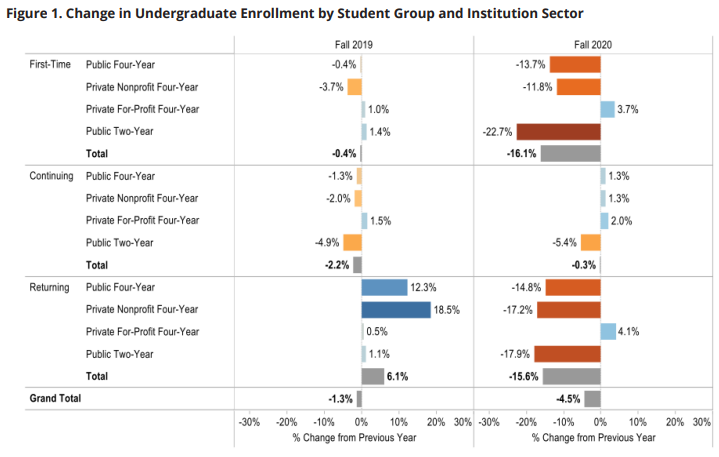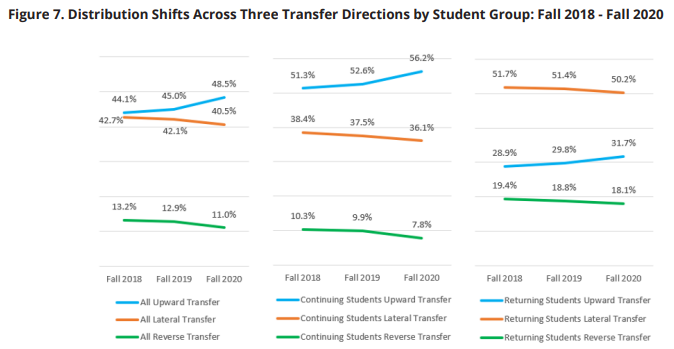enrollment
What the College Transfer Report Stories Got Right—and Wrong
If the maxim “bad news sells” is accurate, 2020 has been a field day for our news outlets. The problem is that when you take an event, a book, an interview, or even a data report and look for the bad news, you can miss not only nuance, but also good news. As I have said in other recent blogs, boy do we need some good news.
I had this thought as I read news stories about the new report on Transfer, Mobility, and Progress from the National Student Clearinghouse last week. Inside Higher Education led with: “Transfer Enrollment Declines: The bad news from about college enrollments continues.” The Chronicle of Higher Education blared “In Another Blow to Student Equity, Transfer to 2-Year Colleges Plunge.”
These calamitous headlines were driven by a couple of points in the college transfer report:
- Transfer enrollment declined 4.7 percent from the previous year (but nearly matching overall enrollment decline of 4.5 percent).
- The proportion of total enrollment comprised of transfer students declined (but only by 0.4 percent from the previous year).
- Transfer into community colleges (“reverse transfer”) from four-year colleges declined by 18.4 percent compared with the previous year (which were already in decline with a 5 percent decline in 2019).
These points were positioned in news accounts as a second hit for community colleges, following reports that community college enrollment declined by about 19 percent (compared to a 4.5 percent decline for overall undergraduate enrollment. The college transfer report further describes:
- First-time community college enrollment declined by 23 percent compared with 16 percent overall.
- Continuing students declined by 5 percent compared with 0.3 percent overall.
- Students re-enrolling after a stop out declined by 18 percent compared with 16 percent overall.

While I don’t want to diminish the challenges that community colleges are facing, in reading through these data you may see my point about over-accentuating the negative. Things are challenging, and they are more challenging at community colleges than elsewhere, but they could have been much, much, worse.
Several of the stories indicated that some stakeholders had thought that the pandemic might provide a boom for community colleges as students opted to stay home, leave their former institutions, and enroll at the local community college. This very clearly did not happen, but it also shows a net positive: students returned to their institutions at much higher numbers than some news stories prognosticated about earlier in the year.
This is a testament to the hard work of a broad array of stakeholders who went into overdrive to maximize student retention in the last six months. Whether through efforts to transition programs to flexible formats allowing students to take each class in a number of formats that work for them, deploying a phalanx of staff to call every student, or through many other initiatives institutions used to adapt to a very fluid situation, these adjustments cumulatively minimized enrollment decline to 4.5 percent (when first-year enrollment was down more than 15 percent).
Talk with our experts about transfer student enrollment
Looking to engage more transfer students and increase how many you enroll? Schedule a free consultation with our enrollment experts.
More good news from the college transfer report
This was the “good news” buried in the bad, but there was another positive point that few reported on: transfer from two- to four-year colleges (upward transfer) increased by 2.6 percent over the previous year. This is the personification of the upward mobility mission of community colleges and the one they should be judged on.

In a recent discussion with the dean of an adult-serving institution, I posed the question: why do you think that adult/post-traditional undergrad enrollment (the typical demographic of our community colleges) did not increase in the wake of the last recession and doesn’t seem to be on the rise during the current situation?
Her response was not what I expected: “I am concerned that socio-demographics are playing a large part. Many students who need to finish an undergraduate degree are not only least able to afford college tuition, but also have the least ability to organize childcare, rearrange work schedules, or understand byzantine policies and procedures.”
It seems to me that she laid out a compelling change agenda in a two sentences: yes, affordability, but also convenience, flexibility, and ease of use.
Read our transfer student research and talk with our experts
For more insights into transfer students, I highly recommend reading our Transfer Student Experience Report and our Transfer Student E-Expectations Report.
We also can talk about your enrollment strategies for transfer students. Just reach out and contact us to schedule a time to chat.
